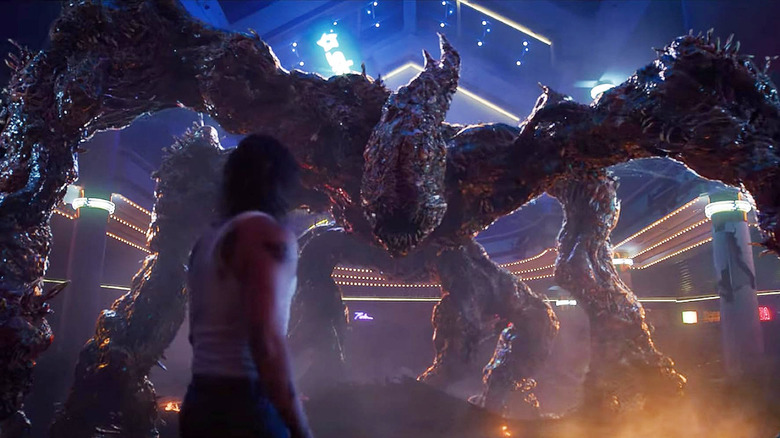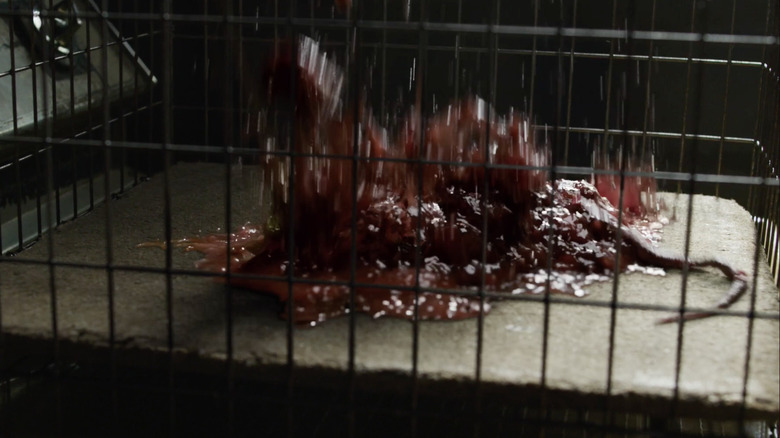Stranger Things' Gory Mind Flayer VFX Were Almost Too Graphic For Netflix
The 1980s was truly a golden era for Gooey Cinema (trademark pending). It wasn't just hard-R horror pictures like David Cronenberg's "The Fly" or Chuck Russell's "The Blob"; from the sheer variety of slimes in the original "Ghostbusters" and "Ghostbusters II" to Marty (Martin Casella) hallucinating peeling bloody wads of skin off his face in "Poltergeist" (not to mention those poor kiddos getting drenched in mudwater and milk in "Honey, I Shrunk the Kids"), filmmakers were always finding excuses to cover the screen — and their actors — with ooze or invent horrifying creatures they could blow up into chunks of gunk à la the "Gremlins" microwave scene.
So, naturally, when the Duffer Brothers got the green light for their '80s sci-fi horror pastiche "Stranger Things," the pair were eager to create all manner of goo-coated monstrosities like the ones they loved growing up. There was just one problem: As one of the show's visual effects supervisors, Martin Pelletier, explained to Vulture in 2019, covering your real-world sets in actual gloop and glop "requires really long reset times, and it's not always convenient," as opposed to the mess-free magic of CGI. That being the case, the Duffers kept things simpler in season 1 by only focusing on the Demogorgon, a creeptastic but not-so-sticky beastie from the alternate dimension known as the Upside Down.
Of course, once the show became a monster hit for Netflix, the Duffers had the capital they needed to indulge their love of viscid effects. "So, going into 'Stranger Things 3,' the number one thing they said was, if we are going to make a creature in CGI, it has to be insanely wet and slimy and stick. Everything has to drip," Pelletier recalled. Even then, however, they couldn't let their gooier dreams run completely wild.
The art of imploding rats
"Stranger Things" season 2 memorably ends with the heroes (primarily Eleven) preventing the all-powerful Mind Flayer from making its way into our world from the Upside Down, only for that nasty bugger to find another entrance near the start of season 3. This was also when the show doubled down on its previous body horror, with the Mind Flayer possessing countless rats at an abandoned steel mill and imploding them to create a grotesque physical body — a creature that Pelletier and his crew dubbed "The Goop" — through which it could interact with (and, in time, even possess) people in Hawkins.
"Implode" is, in fact, the correct word here. "You're not looking for guts and blood to splatter all over the place like a grenade effect," Pelletier noted. "You want the rats to sort of flip inside out, instantly. It would splatter, but not separate into isolated chunks." This presented challenges of its own, he explained:
"The problem was, as much as the Duffers loved gore, they said they would have a hard time getting it through Netflix if it was too descriptive — that is, once the rats start flipping inside out, we had to be careful not to make it too biological, where we can see the heart and the lungs and the eyeballs. It had to be something that looked nasty but on that thin line between spooky-cool and outright gory."
To accomplish this, Pelletier and his team devised "a system using an animated rig rat asset and a recipe from the creature effect department. We could make it flip inside out and hide the fur instantly in a thick pile of nondescript guts and blood and mucus." The end result perhaps isn't quite as disturbing or visceral as '80s monster movie practical effects at their nastiest (think the dog-Thing hybrid from John Carpenter's "The Thing"), but it certainly gets the job done.

